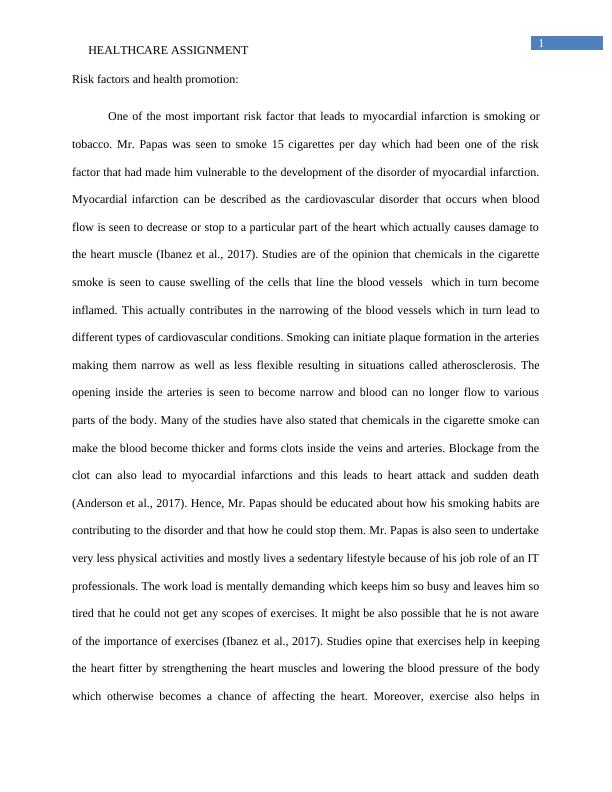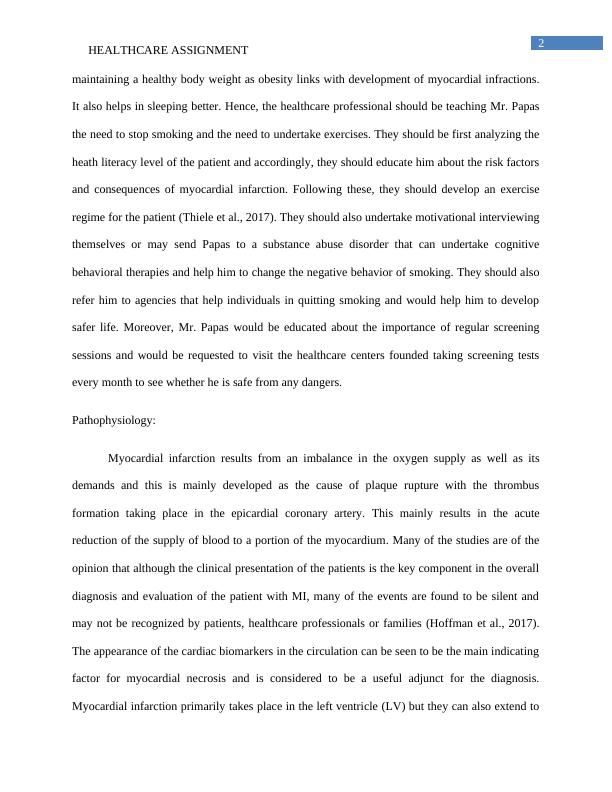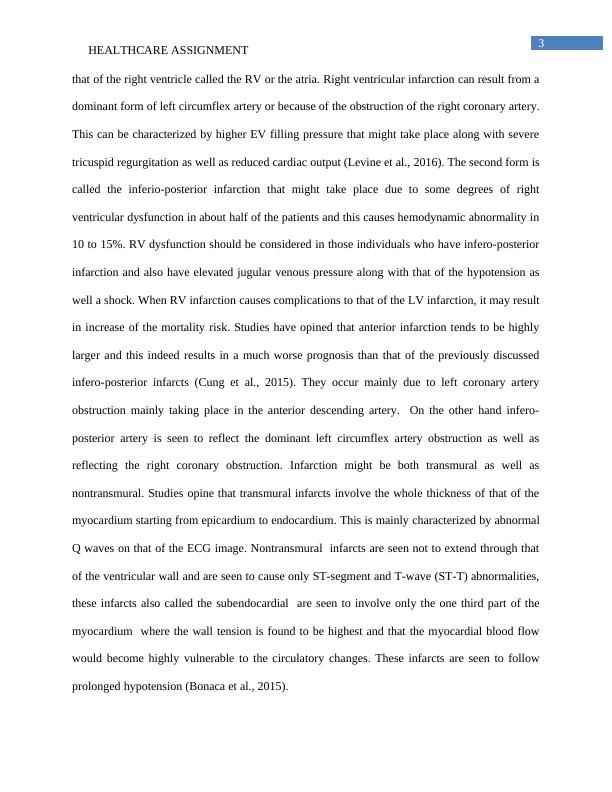Risk Factors and Health Promotion in Myocardial Infarction
Added on 2022-12-26
16 Pages4451 Words20 Views
Running head: HEALTHCARE ASSIGNMENT
HEALTHCARE ASSIGNMENT
Name of the student:
Name of the university:
Author note:
HEALTHCARE ASSIGNMENT
Name of the student:
Name of the university:
Author note:

1
HEALTHCARE ASSIGNMENT
Risk factors and health promotion:
One of the most important risk factor that leads to myocardial infarction is smoking or
tobacco. Mr. Papas was seen to smoke 15 cigarettes per day which had been one of the risk
factor that had made him vulnerable to the development of the disorder of myocardial infarction.
Myocardial infarction can be described as the cardiovascular disorder that occurs when blood
flow is seen to decrease or stop to a particular part of the heart which actually causes damage to
the heart muscle (Ibanez et al., 2017). Studies are of the opinion that chemicals in the cigarette
smoke is seen to cause swelling of the cells that line the blood vessels which in turn become
inflamed. This actually contributes in the narrowing of the blood vessels which in turn lead to
different types of cardiovascular conditions. Smoking can initiate plaque formation in the arteries
making them narrow as well as less flexible resulting in situations called atherosclerosis. The
opening inside the arteries is seen to become narrow and blood can no longer flow to various
parts of the body. Many of the studies have also stated that chemicals in the cigarette smoke can
make the blood become thicker and forms clots inside the veins and arteries. Blockage from the
clot can also lead to myocardial infarctions and this leads to heart attack and sudden death
(Anderson et al., 2017). Hence, Mr. Papas should be educated about how his smoking habits are
contributing to the disorder and that how he could stop them. Mr. Papas is also seen to undertake
very less physical activities and mostly lives a sedentary lifestyle because of his job role of an IT
professionals. The work load is mentally demanding which keeps him so busy and leaves him so
tired that he could not get any scopes of exercises. It might be also possible that he is not aware
of the importance of exercises (Ibanez et al., 2017). Studies opine that exercises help in keeping
the heart fitter by strengthening the heart muscles and lowering the blood pressure of the body
which otherwise becomes a chance of affecting the heart. Moreover, exercise also helps in
HEALTHCARE ASSIGNMENT
Risk factors and health promotion:
One of the most important risk factor that leads to myocardial infarction is smoking or
tobacco. Mr. Papas was seen to smoke 15 cigarettes per day which had been one of the risk
factor that had made him vulnerable to the development of the disorder of myocardial infarction.
Myocardial infarction can be described as the cardiovascular disorder that occurs when blood
flow is seen to decrease or stop to a particular part of the heart which actually causes damage to
the heart muscle (Ibanez et al., 2017). Studies are of the opinion that chemicals in the cigarette
smoke is seen to cause swelling of the cells that line the blood vessels which in turn become
inflamed. This actually contributes in the narrowing of the blood vessels which in turn lead to
different types of cardiovascular conditions. Smoking can initiate plaque formation in the arteries
making them narrow as well as less flexible resulting in situations called atherosclerosis. The
opening inside the arteries is seen to become narrow and blood can no longer flow to various
parts of the body. Many of the studies have also stated that chemicals in the cigarette smoke can
make the blood become thicker and forms clots inside the veins and arteries. Blockage from the
clot can also lead to myocardial infarctions and this leads to heart attack and sudden death
(Anderson et al., 2017). Hence, Mr. Papas should be educated about how his smoking habits are
contributing to the disorder and that how he could stop them. Mr. Papas is also seen to undertake
very less physical activities and mostly lives a sedentary lifestyle because of his job role of an IT
professionals. The work load is mentally demanding which keeps him so busy and leaves him so
tired that he could not get any scopes of exercises. It might be also possible that he is not aware
of the importance of exercises (Ibanez et al., 2017). Studies opine that exercises help in keeping
the heart fitter by strengthening the heart muscles and lowering the blood pressure of the body
which otherwise becomes a chance of affecting the heart. Moreover, exercise also helps in

2
HEALTHCARE ASSIGNMENT
maintaining a healthy body weight as obesity links with development of myocardial infractions.
It also helps in sleeping better. Hence, the healthcare professional should be teaching Mr. Papas
the need to stop smoking and the need to undertake exercises. They should be first analyzing the
heath literacy level of the patient and accordingly, they should educate him about the risk factors
and consequences of myocardial infarction. Following these, they should develop an exercise
regime for the patient (Thiele et al., 2017). They should also undertake motivational interviewing
themselves or may send Papas to a substance abuse disorder that can undertake cognitive
behavioral therapies and help him to change the negative behavior of smoking. They should also
refer him to agencies that help individuals in quitting smoking and would help him to develop
safer life. Moreover, Mr. Papas would be educated about the importance of regular screening
sessions and would be requested to visit the healthcare centers founded taking screening tests
every month to see whether he is safe from any dangers.
Pathophysiology:
Myocardial infarction results from an imbalance in the oxygen supply as well as its
demands and this is mainly developed as the cause of plaque rupture with the thrombus
formation taking place in the epicardial coronary artery. This mainly results in the acute
reduction of the supply of blood to a portion of the myocardium. Many of the studies are of the
opinion that although the clinical presentation of the patients is the key component in the overall
diagnosis and evaluation of the patient with MI, many of the events are found to be silent and
may not be recognized by patients, healthcare professionals or families (Hoffman et al., 2017).
The appearance of the cardiac biomarkers in the circulation can be seen to be the main indicating
factor for myocardial necrosis and is considered to be a useful adjunct for the diagnosis.
Myocardial infarction primarily takes place in the left ventricle (LV) but they can also extend to
HEALTHCARE ASSIGNMENT
maintaining a healthy body weight as obesity links with development of myocardial infractions.
It also helps in sleeping better. Hence, the healthcare professional should be teaching Mr. Papas
the need to stop smoking and the need to undertake exercises. They should be first analyzing the
heath literacy level of the patient and accordingly, they should educate him about the risk factors
and consequences of myocardial infarction. Following these, they should develop an exercise
regime for the patient (Thiele et al., 2017). They should also undertake motivational interviewing
themselves or may send Papas to a substance abuse disorder that can undertake cognitive
behavioral therapies and help him to change the negative behavior of smoking. They should also
refer him to agencies that help individuals in quitting smoking and would help him to develop
safer life. Moreover, Mr. Papas would be educated about the importance of regular screening
sessions and would be requested to visit the healthcare centers founded taking screening tests
every month to see whether he is safe from any dangers.
Pathophysiology:
Myocardial infarction results from an imbalance in the oxygen supply as well as its
demands and this is mainly developed as the cause of plaque rupture with the thrombus
formation taking place in the epicardial coronary artery. This mainly results in the acute
reduction of the supply of blood to a portion of the myocardium. Many of the studies are of the
opinion that although the clinical presentation of the patients is the key component in the overall
diagnosis and evaluation of the patient with MI, many of the events are found to be silent and
may not be recognized by patients, healthcare professionals or families (Hoffman et al., 2017).
The appearance of the cardiac biomarkers in the circulation can be seen to be the main indicating
factor for myocardial necrosis and is considered to be a useful adjunct for the diagnosis.
Myocardial infarction primarily takes place in the left ventricle (LV) but they can also extend to

3
HEALTHCARE ASSIGNMENT
that of the right ventricle called the RV or the atria. Right ventricular infarction can result from a
dominant form of left circumflex artery or because of the obstruction of the right coronary artery.
This can be characterized by higher EV filling pressure that might take place along with severe
tricuspid regurgitation as well as reduced cardiac output (Levine et al., 2016). The second form is
called the inferio-posterior infarction that might take place due to some degrees of right
ventricular dysfunction in about half of the patients and this causes hemodynamic abnormality in
10 to 15%. RV dysfunction should be considered in those individuals who have infero-posterior
infarction and also have elevated jugular venous pressure along with that of the hypotension as
well a shock. When RV infarction causes complications to that of the LV infarction, it may result
in increase of the mortality risk. Studies have opined that anterior infarction tends to be highly
larger and this indeed results in a much worse prognosis than that of the previously discussed
infero-posterior infarcts (Cung et al., 2015). They occur mainly due to left coronary artery
obstruction mainly taking place in the anterior descending artery. On the other hand infero-
posterior artery is seen to reflect the dominant left circumflex artery obstruction as well as
reflecting the right coronary obstruction. Infarction might be both transmural as well as
nontransmural. Studies opine that transmural infarcts involve the whole thickness of that of the
myocardium starting from epicardium to endocardium. This is mainly characterized by abnormal
Q waves on that of the ECG image. Nontransmural infarcts are seen not to extend through that
of the ventricular wall and are seen to cause only ST-segment and T-wave (ST-T) abnormalities,
these infarcts also called the subendocardial are seen to involve only the one third part of the
myocardium where the wall tension is found to be highest and that the myocardial blood flow
would become highly vulnerable to the circulatory changes. These infarcts are seen to follow
prolonged hypotension (Bonaca et al., 2015).
HEALTHCARE ASSIGNMENT
that of the right ventricle called the RV or the atria. Right ventricular infarction can result from a
dominant form of left circumflex artery or because of the obstruction of the right coronary artery.
This can be characterized by higher EV filling pressure that might take place along with severe
tricuspid regurgitation as well as reduced cardiac output (Levine et al., 2016). The second form is
called the inferio-posterior infarction that might take place due to some degrees of right
ventricular dysfunction in about half of the patients and this causes hemodynamic abnormality in
10 to 15%. RV dysfunction should be considered in those individuals who have infero-posterior
infarction and also have elevated jugular venous pressure along with that of the hypotension as
well a shock. When RV infarction causes complications to that of the LV infarction, it may result
in increase of the mortality risk. Studies have opined that anterior infarction tends to be highly
larger and this indeed results in a much worse prognosis than that of the previously discussed
infero-posterior infarcts (Cung et al., 2015). They occur mainly due to left coronary artery
obstruction mainly taking place in the anterior descending artery. On the other hand infero-
posterior artery is seen to reflect the dominant left circumflex artery obstruction as well as
reflecting the right coronary obstruction. Infarction might be both transmural as well as
nontransmural. Studies opine that transmural infarcts involve the whole thickness of that of the
myocardium starting from epicardium to endocardium. This is mainly characterized by abnormal
Q waves on that of the ECG image. Nontransmural infarcts are seen not to extend through that
of the ventricular wall and are seen to cause only ST-segment and T-wave (ST-T) abnormalities,
these infarcts also called the subendocardial are seen to involve only the one third part of the
myocardium where the wall tension is found to be highest and that the myocardial blood flow
would become highly vulnerable to the circulatory changes. These infarcts are seen to follow
prolonged hypotension (Bonaca et al., 2015).

End of preview
Want to access all the pages? Upload your documents or become a member.
Related Documents
Case Study of Mr. Papaslg...
|14
|4347
|27
Case Study of Mr. Papaslg...
|15
|4622
|45
Case Study of ST-Elevated Myocardial Infarctionlg...
|9
|3304
|1
Nursing Case Study Assignmentlg...
|12
|3767
|49
Case Study on Cardiovascularlg...
|10
|2204
|31
Case Study on Patient Liz: Vulnerability to Cardiovascular Disorderslg...
|9
|2395
|138
